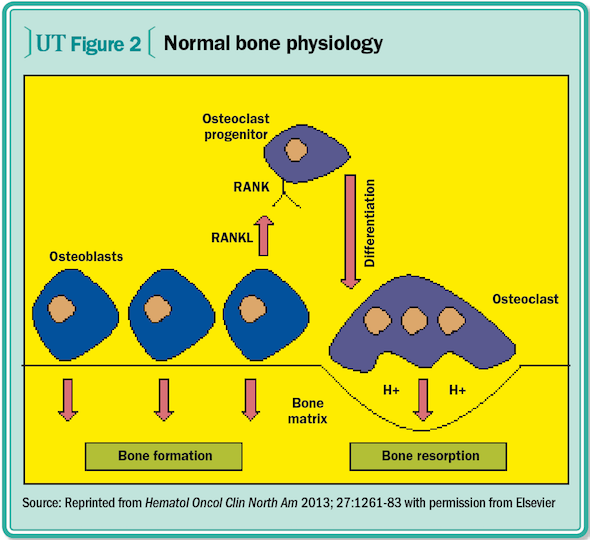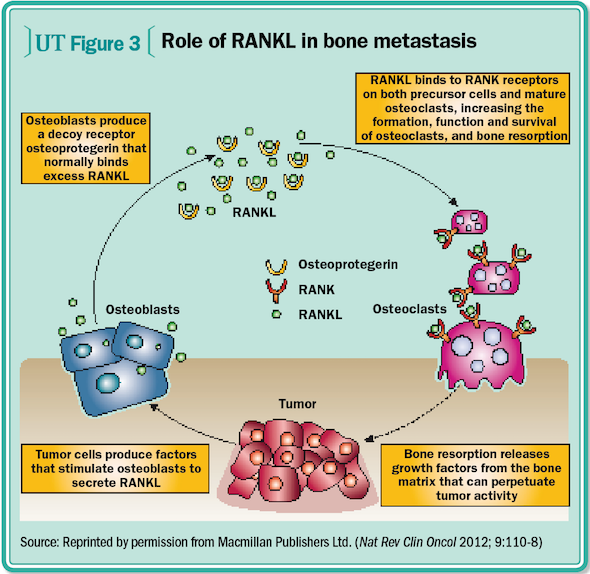Article
Managing bone health in men with metastatic prostate cancer
Author(s):
Christopher Amling, MD, describes strategies to reduce skeletal-related morbidity, including lifestyle changes, calcium and vitamin D supplementation, and pharmacologic therapy.

Dr. Amling is professor of urology at Oregon Health & Science University, Portland.
Bone is a frequent site of metastases in men with advanced prostate cancer, and bony involvement accounts for much of the morbidity of late-stage disease. When prostate cancer cells invade the bone environment, they disrupt the normal bone remodeling process and weaken the bone structure, potentially resulting in skeletal complications. These skeletal complications, often referred to as skeletal-related events (SREs), include bone pain, pathologic fractures, and spinal cord compression requiring intervention (surgery, radiotherapy, or a change in therapy).
ALSO SEE - PTNS for overactive bladder: Patient selection and technique
Men with metastatic prostate cancer have further compromise of bone integrity by the use of androgen deprivation therapy (ADT), the mainstay of treatment in metastatic disease. Androgen deprivation accelerates physiologic bone resorption, leading to osteoporosis and bone fragility fractures.
These disease burdens and treatment-related threats to bone integrity in men with metastatic prostate cancer make bone health an important consideration. In this context, bone health includes the diagnosis, prevention, and treatment of metastasis and ADT-induced bone loss as well as their respective complications of osteoporotic fractures and SREs. In men with metastatic castrate-resistant prostate cancer (mCRPC), skeletal tumor burden, bone pain, and fracture are all independent predictors of death. Thus, preserving bone health to the greatest extent possible can improve both the quality and quantity of life for these men.
This article describes strategies to reduce skeletal-related morbidity, including lifestyle changes, calcium and vitamin D supplementation, and pharmacologic therapy.
NEXT: Treatment-related osteoporosis
More from Urology Times
Oncofertility: Current practice and vision for the future
How to manage testicular/groin pain: Medical and surgical ladder
How to prevent stone formation in patients with metabolic syndrome
Treatment-related osteoporosis
ADT is the mainstay of systemic treatment for metastatic prostate cancer, but it also causes severe hypogonadism, a common cause of osteoporosis in men. In men receiving ADT, rapid rates of bone mineral density loss can occur within the initial 12 months of treatment, ranging from 2% to 8% bone loss in the lumbar spine and 1.8% to 6.5% in the femoral neck (Cancer 2004; 100:892-9). These rates of bone loss are significantly higher than the average bone loss rate of 0.5% per year in men 50 years and older who are not receiving ADT (Rev Urol 2007; 9:163-80). With this level of bone loss, the probability of developing osteoporosis increases substantially and directly correlates with the duration of ADT use (figure 1) (Urology 2007; 69:500-4).

The ADT-induced decrease in bone mineral density is also associated with an increased risk of osteoporosis-related bone fractures. A large SEER/Medicare study of over 50,000 prostate cancer patients found an overall fracture rate after 5 years of 19.4% among those receiving ADT compared to 12.6% among those who did not (N Engl J Med 2005; 352:154-64). An estimated 3,000 fractures a year were attributable to GnRH agonist use.
NEXT: Monitoring, prevention
Monitoring, prevention. When initiating ADT for treatment of advanced prostate cancer, it is important to identify baseline comorbidities and other risk factors for development of osteoporosis. Risk factors such as age, smoking, physical inactivity, caffeine and alcohol consumption, prior fracture, and family history of fracture put these men at increased risk for development of osteoporosis and treatment-induced bone loss. National Comprehensive Cancer Network (NCCN) guidelines recommend assessing fracture risk using the WHO Fracture Risk Assessment Tool (FRAX) algorithm (J Urol 2010; 183:2200-5). This risk assessment tool combined with bone mineral density measurements can guide physicians in decisions about who should be treated for ADT-induced bone loss.
READ - Men's health: How urology and primary care can work together
Dual energy x-ray absorptiometry (DEXA) is used to monitor bone mineral density during treatment, with the spine being the preferred site for serial measurements of bone mass. On DEXA scan, the T score reports the number of standard deviations the patient’s bone mineral density value falls between, above or below that of a healthy 30-year-old adult. Fracture risk increases approximately twofold for every standard deviation decrease in bone mineral density. A normal T score yields values greater than -1.0, with osteopenia defined by a T score between -1.0 and -2.5 and osteoporosis defined as a T score of less than or equal to -2.5.
The NCCN guidelines recommend screening for osteoporosis in men with prostate cancer according to the National Osteoporosis Foundation (NOF) guidelines for the general population(J Natl Compr Canc Netw 2013; 11[suppl 3]:S1–S50). Guidelines from the European Association of Urology recommend performing a DEXA scan every 2 years after initiation of castration providing there are no other risk factors, and annually if there are osteoporosis risk factors (Eur Urol 2014; 65:467-79). As a general rule, obtaining a baseline DEXA scan upon initiation of ADT is advisable.
Since a significant decrease in bone density can be seen the first 12 months of therapy, a repeat DEXA scan after 1 year of treatment is also reasonable. The frequency of repeat DEXA scans after the first year can be based on the degree of bone mineral density decrease, other risk factors for osteoporosis, and whether treatment for osteoporosis has been initiated.
Calcium and vitamin D supplementation are commonly recommended in men receiving ADT, although no randomized trials have tested whether these supplements improve bone mineral density in this population. Clinical trials testing other agents for bone density preservation in men without prostate cancer have used calcium (500-1,000 mg/d) and vitamin D (200-500 IU/d) in the control arms, but these doses are likely too low to prevent bone loss in ADT-treated men (Oncologist 2012; 17:1171-9).
ALSO SEE: High-risk prostate cancer brings new challenge
The NOF currently recommends a calcium intake of at least 1,200 mg/d from diet and supplements, and supplemental vitamin D of 800-1,000 IU/d (J Natl Compr Canc Netw 2013; 11[suppl 3]:S1–S50). These doses are a reasonable recommendation for men on ADT, although some may require higher dose vitamin D supplementation if baseline serum levels are low. Ultimately, all patients initiating ADT should also be tested for vitamin D deficiency by measurement of serum 25-hydroxy vitamin D.
NEXT: Bone metastases and skeletal complications
Bone metastases and skeletal complications
Normal bone remodeling involves the coordinated actions of osteoclasts, which are cells responsible for bone resorption, and osteoblasts, which mediate bone formation. The osteoblasts and bone marrow stromal cells release RANK ligand (RANKL), which binds to RANK on osteoclast precursor cells. This process promotes differentiation and activation of osteoclasts, which then bind to bone matrix, leading to bone resorption. The osteoclasts form a cell layer over the bone surface, on which the matrix is formed and subsequently demineralized to become bone (figure 2) (Hematol Oncol Clin North Am 2013; 27:1261-83).

Bone metastases promote increased osteoblast and osteoclast activity, as evidenced by increases in biochemical markers of bone turnover. It is postulated that interactions between tumor cells in the bone microenvironment result in a vicious cycle of bone destruction and tumor growth. Tumor cells secrete cytokines and other factors that activate osteoblasts to produce RANKL, leading to activation of osteoclast precursors and subsequent osteolysis (figure 3)(Nat Rev Clin Oncol 2012; 9:110-8). The process of bone resorption releases additional factors that promote tumor cell proliferation and further production of resorption-promoting factors, propagating the vicious cycle of osteolysis and tumor growth.
NEXT: Pharmacologic prevention of osteoporosis, SREs
Pharmacologic prevention of osteoporosis, SREs
Men receiving ADT for prostate cancer should be counseled on lifestyle modification, including smoking cessation, moderating alcohol and caffeine consumption, and regular weight-bearing exercises and resistance training. Fall prevention is also critical in reducing the risk of bone fracture. Despite these lifestyle modifications, however, pharmacologic treatment is often required. Pharmacologic interventions should be individualized with the primary focus on prevention and/or treatment of osteoporosis and the prevention of SREs.

Zoledronic acid. Bisphosphonates as a class are potent inhibitors of bone resorption. Zoledronic acid is the only bisphosphonate shown to demonstrate a beneficial effect in mCRPC. In a phase II randomized trial, IV zoledronic acid, 4 mg every 3 weeks, decreased the incidence of SREs by 36% (J Natl Cancer Inst 2004; 96:879-82). Longer therapy (up to 24 months) appears to confer continued benefit, even in patients who have experienced an SRE. The toxicity of this therapy includes both hypocalcemia and nephrotoxicity. As such, serum creatinine and calcium levels should be obtained prior to each treatment with appropriate dose modifications as necessary.
For treatment of osteoporosis, zoledronic acid (Reclast) can be given once a year as a 5-mg IV infusion. When given for the prevention of SRE, zoledronic acid (Zometa) is dosed more frequently: 4 mg IV every 3 to 4 weeks.
NEXT: Denosumab
Denosumab. RANKL and its inhibitors are important molecules involved in bone turnover, as RANKL is an important driver of osteoclast function and survival. Denosumab is a human monoclonal antibody directed against RANKL, which inhibits osteoclast-mediated bone destruction. In patients with non-metastatic disease receiving ADT, denosumab has been shown to actually increase bone mineral density at the hip, femoral neck, and lumbar spine, and decrease the incidence of vertebral fractures.
In a randomized trial in over 1,900 patients with mCRPC, subcutaneous denosumab demonstrated a longer time to first SRE compared to IV zoledronic acid given once every 4 weeks, but also resulted in more significant hypocalcemia. Patients receiving zoledronic acid required baseline dose adjustment based on renal function, and an additional 15% required dose modifications due to serum creatinine levels while on study. Osteonecrosis of the jaw (discussed below), a significant potential complication of both drugs, was uncommon in both arms (2% denosumab, 1% zoledronic acid) (Lancet 2011; 377:813-22).
For the treatment of osteoporosis, denosumab (Prolia) can be given subcutaneously at a dose of 60 mg every 6 months. To decrease the probability of SRE, denosumab (XGEVA) is given at a much higher dose and more frequently (every 4 weeks at a dose of 120 mg subcutaneously). When prescribing denosumab, adding supplemental calcium and monitoring serum calcium level are recommended. Preexisting hypocalcemia must be corrected prior to initiating this therapy. There is no need for dose adjustment based on renal function.
Osteonecrosis of the jaw. Both bisphosphonates and denosumab can cause osteonecrosis of the jaw, a rare but devastating side effect. Patients who are being considered for either of these bone-targeting agents should be screened for risk factors that put them at higher risk for this complication. These include dental surgery during treatment, poorly fitting dentures, poor oral health, or a history of oral disease. Prevention of osteonecrosis of the jaw requires monitoring of dental health and avoiding invasive dental procedures once therapy has started. Patients should have a complete oral examination prior to initiation of treatment and regular dental checkups during treatment to optimize oral health and to identify the early development of osteonecrosis of the jaw.
NEXT: Conclusions
Conclusions
Since bone is the most frequent site of metastatic disease in men with prostate cancer and ADT can result in significant treatment-related osteoporosis, preservation of bone health is an important consideration, especially in men with mCRPC. Strategies to reduce skeletal-related morbidity include lifestyle modifications, calcium and vitamin D supplementation, and the utilization of osteoclast-targeted agents in patients at high risk for either SREs or osteoporotic fractures. For those patients receiving ADT, bone mineral density should be determined and periodically reassessed using DEXA scan, especially in patients with additional risk factors for osteoporosis.
The bisphosphonates and denosomab can correct osteoporosis and effectively delay skeletal-related complications. As such, they should be considered as part of the standard treatment of patients with mCRPC. However, the adverse effects of these drugs must be anticipated and adjusted for, and there is no current evidence supporting the use of these agents to prevent SREs in hormone-naïve or hormone-responsive patients.

You might also like:
Targeted prostate biopsy: Momentum grows, but questions remain
Race a factor in prostate cancer risk reclassification
RT commonly prescribed regardless of Ca stage, PSA level
Subscribe to Urology Times to get monthly news from the leading news source for urologists.

















